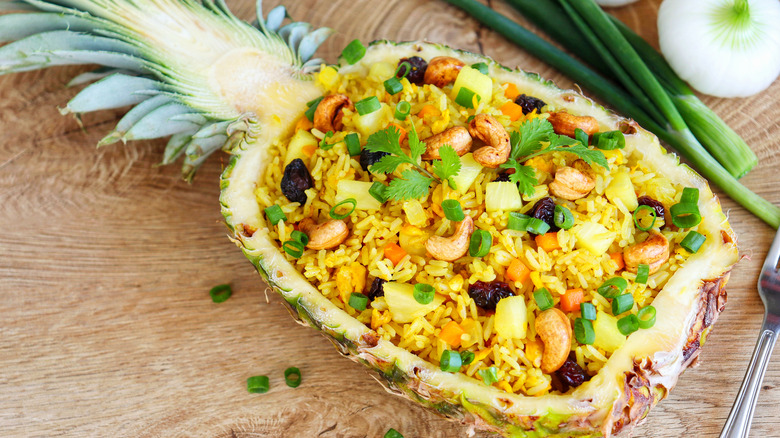Should People With Diabetes Eat Pineapple?
We may receive a commission on purchases made from links.
If you have diabetes and you're unsure what's safe to eat, you're not alone. In 2019, 11.3% of the U.S. population had diabetes (per American Diabetes Association). Managing the condition requires a mixture of medication and a carefully planned diet. Sugary foods and carbs are generally off-limits, and even naturally-occurring sugars can cause rapid sugar spikes. There's an air of confusion around which foods are healthy and which ones diabetics should refrain from. Could fresh fruit be harmful to people with diabetes?
Diabetes is a condition when the body doesn't properly use or produce enough insulin (via Diabetes.org). Insulin transports sugar (glucose) from food into our cells for energy. A bloodstream lacking insulin makes for frequent fatigue and high blood sugar levels (per Endocrine Society). What's the key to high energy and balanced blood glucose? A clean diet. Even if you think you have diabetes, MedlinePlus recommends making low-carb meals and sugar-free drinks the norm. While these disciplines help maintain blood sugar levels, there are sweet foods that people aren't sure about.
Bursting with vitamins and antioxidants, pineapple is a delicious source of healthy sugars, according to Livestrong. Pineapple ranks as a medium on the glycemic index (a system that ranks carbs by how quickly they affect blood sugar) but has a low glycemic load. Livestrong notes that glycemic load may be an even better indicator of how a food impacts blood sugar. Generally, foods lower on the GI are diabetic-approved. But is pineapple one of them?
Pineapple is safe for diabetics
Don't fall for the "fruit is bad" mantra — it's actually a myth. Whether someone has type 1 or type 2 diabetes, they can enjoy fresh fruit — even pineapple — in moderation. Exercising portion control is important when diabetics choose their carbs. Carbohydrates with high glycemic loads are a more risky choice because they enter the bloodstream quickly and cause blood sugar spikes (via Healthline). NHS Inform mentions that small hyperglycemia episodes can be easily corrected. However, having prolonged high blood sugar causes damage to the kidneys, blood vessels, eyes, and nerves. High GI (processed) foods that skyrocket glucose levels are sugary treats, pineapple canned in syrup, and sweetened juices. The Healthy proposes looking for fruit canned in all-natural juice rather than syrup. When shopping for juices, check ingredients to avoid added sugars.
When you're enjoying a slice of this rich yellow fruit, fresh is best. Experts at The Healthy note that a cup of this juicy fruit is filled with an abundance of vitamin C, fiber, and potassium. One cup carries about 19 grams of carbs. If you're carb counting, fiber helps delay glucose entering into the blood. Mary Ellen Phipps, R.D. and author of the "Easy Diabetes Cookbook" suggests having pineapple alongside another macro. She says, "To promote more stable blood sugar levels after eating pineapple, make sure to pair it with a source of protein or plant-based fat." It's safe to add this tropical taste to your palette. Reading nutrition labels at the store will help you learn more about the ingredients.
Enjoy pineapple in moderation
We covered which types of pineapple are best, now let's discuss how to eat it. You can nibble on a few slices from a fruit tray, and Medical News Today adds that diabetics can consume frozen pineapple as well. You may want to refrain from dried pineapple, since the dehydration process draws out the water and hikes up the sugar content, according to SF Gate.
How you enjoy pineapple also depends on the time of day you indulge and whether you eat it solo or for dessert. Experts at Medical News Today advise eating pineapple with or after having fiber, protein, or fatty foods. You can also find fun ways to include pineapple in your recipes. For example, you may garnish grilled snapper with pineapple salsa (the healthy fat), blend a fresh cup of pineapple into a protein smoothie (there's your protein), or grill pineapple with brown rice (a great source of fiber). That's It notes that the bromelain enzyme in pineapple juice breaks up protein, and it can be used to tenderize meat. Your options are endless.
Since physical activity is encouraged with any diet, you may want to put that sugar to use and exercise after you bite into a slice. The American Diabetes Association confirms that body movement can reduce blood sugar levels. Diabetics can enjoy the sweet and savory flavors of pineapple, and measuring portions will help regulate carb intake. For best results, enjoy fresh fruit and check your blood sugar regularly.



